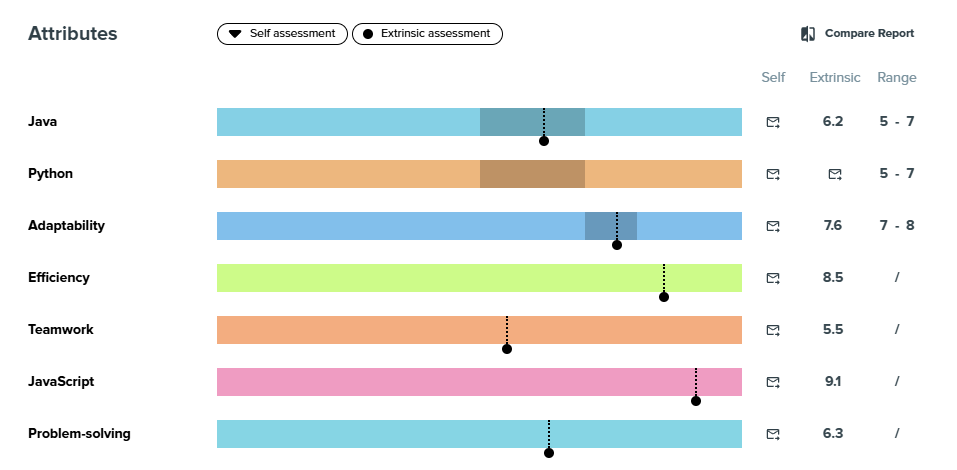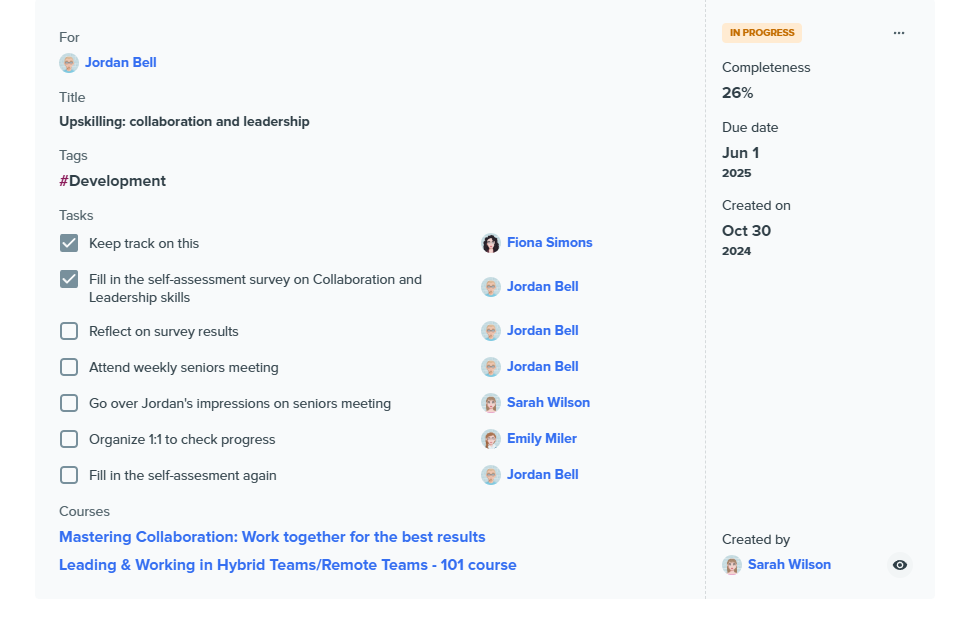For many growing teams, HR processes still depend on manual coordination and repetitive tasks. Feedback is requested individually. Performance data is compiled manually from various sources. Review cycles are set up from scratch every quarter, with no system to tie feedback, development plans, and follow-ups together.
This kind of labor-intensive work often goes unnoticed until the team scales and the time loss becomes too large to ignore. What used to take an afternoon now takes a week. HR spends more time chasing input than enabling performance. And managers lose trust in the process because nothing feels connected or conclusive.
This article breaks down how much time is lost in fragmented HR workflows and why manual fixes don’t scale. It shows how HR automation can connect feedback, data, and reporting into one structured system using HR automation tools and process automation in HR.
Why manual HR work becomes unsustainable as you grow
In small teams, most HR processes happen informally. A performance review might mean sending a quick Google Form. Feedback is gathered in Slack. Development notes live in someone’s Notion doc. It’s fast, lightweight, and, at first, it works.
But that only lasts until the team starts to grow.
Once you move past 30 or 40 people, those same manual tasks begin to slow everything down. HR has to explain the review process multiple times. Managers create their versions of what a review should look like. Feedback is submitted late or in the wrong format. And somehow, all of it has to come back together into a usable report, often rebuilt from scratch, every quarter.
That’s where process automation in HR becomes important. It replaces repetitive coordination with a structured system that scales.
What does “manual” actually mean in HR?
The manual doesn’t just mean “paper-based.” It means work that requires someone to coordinate, follow up, or reformat, even when the content already exists. These are tasks that don’t look broken on the surface but take hours when repeated across dozens of people.
🕓 Common manual tasks HR teams are stuck repeating:
- Building surveys from scratch each cycle
- Sending feedback requests manually via email or Slack
- Recreating templates for every team or role
- Formatting reports manually in spreadsheets
- Following up on missed responses, one by one
Most of this goes unnoticed; it feels like “just part of the job.” But when a single feedback cycle starts requiring 10+ hours of prep, coordination, and cleanup, it becomes clear: the process doesn’t scale, even if the team does.
The hidden cost of labor-intensive HR tasks
Manual HR work doesn’t just cost time; it also costs money. It costs attention, consistency, and trust. And yet, it’s often invisible. Because the job gets done. The surveys are sent. The reviews happen. Feedback is shared. However, what’s hidden is the amount of effort it took and what that effort displaced.
Let’s take a typical performance cycle for a 40-person organization. The HR team creates review forms from scratch, manually assigns them, writes reminder emails, and builds a spreadsheet to track who’s completed what. Peer feedback comes in late. Self-evaluations are scattered. The manager is confused about what to do next. And when it’s over, HR spends hours compiling a report that leadership may or may not read on time.
By introducing HR automation tools, all these steps can be streamlined into a single workflow, reducing manual tasks and freeing time for higher-value work.
How much time is actually lost?
When this work is spread across a team, it feels like a shared responsibility. But in reality, it fragments everyone’s focus. HR loses time that could be spent on coaching or strategy. Managers lose time that should be used for team conversations. Employees lose momentum because there’s no clear thread between review, feedback, and follow-up.
The manual doesn’t mean simple; it just means unpaid complexity.
💡 According to McKinsey, more than half (56%) of traditional HR tasks, from routine data collection to process coordination, can be automated with current technologies, enabling a 66% reduction in processing time.
What else gets lost?
⛔ Continuity: each cycle starts from scratch. Different forms, different formats, different priorities.
⛔ Clarity: employees don’t know what to expect; managers make it up as they go.
⛔ Credibility: HR looks like operations, not a strategic partner.
What suffers most isn’t the process itself; it’s the value people derive from it. Implementing HR process automation ensures continuity, clarity, and consistency across every review cycle.
What HR automation looks like in practice
HR automation doesn’t mean removing people; it means eliminating the parts of the process that shouldn’t require them in the first place. That’s not just about saving time. It’s about creating a performance cycle that works: structured, repeatable, and aligned with the organization's operations.
To understand the difference, let’s look at how performance reviews typically unfold first manually and then in an automated system.
❌ Manual: a process you rebuild every time
In most growing teams, performance reviews still run on a patchwork of tools. HR builds the process from scratch or borrows last quarter’s version, hoping nothing breaks. The result might look organized on the surface, but underneath, every piece is held together by extra work that no one has time for.
- You create feedback forms from scratch or duplicate last quarter’s.
- You manually assign them to each reviewer.
- You send reminders over Slack or email.
- You track completion in a spreadsheet.
- You copy feedback into documents or summaries.
- You create reports manually in Excel.
- You hope managers turn that into something actionable.
Each step adds friction, and most of it is invisible until it’s too late.
💡 A report by Recruiter indicates that 55% of managers spend at least eight hours a week on manual and repetitive administrative tasks, taking away from actual leadership and employee development. Automation of HR processes prevents this drain by standardizing repetitive workflows.
✅ Automated: a process that runs without rework
In an automated system, performance reviews don’t start from scratch each quarter; they follow a consistent, connected flow. HR launches a review cycle once, using pre-configured templates that already reflect role levels and core skills. The right reviewers are notified automatically, and their input is routed into a shared, structured view, eliminating the need for exporting, reformatting, or chasing down updates.
Instead of spending hours organizing feedback, HR focuses on what the input reveals. Instead of managers guessing what to do with the results, they’re immediately guided toward action, with suggested next steps, linked development areas, and a shared action plan already tied to the next 1:1 meeting.
This doesn’t just save time. It creates continuity. Everyone involved in the process knows where they are, what comes next, and what has changed since the last quarter without having to dig through scattered files or repeat the same steps over and over.
AIHR’s video, “HR Automation: How To Unlock Efficiency [2025],” demonstrates how HR automation eliminates repetitive tasks from HR workflows without adding complexity. It reinforces the same issue explored in this article: growing teams struggle with fragmented tools and manual coordination, when what they need is a single, connected system.
From onboarding to performance reviews, the lesson remains the same: HR process automation saves time, improves collaboration, and drives clarity.
Why does fixing this manually not work
When HR teams start feeling the pressure of repetitive tasks, their first instinct is usually to patch the process manually. Build a better spreadsheet. Tweak the survey template. Create another Notion doc. Copy and paste last quarter’s structure just to get through the next cycle.
And it works for a while. But with every cycle, the manual overhead increases. Feedback gets delayed, input gets lost, and reviews become inconsistent. What started as a lightweight process becomes heavier each time until HR is spending more time managing tools than supporting people.
Managers also lose confidence. When the process feels improvised, it’s harder to take it seriously. People stop engaging, not because they don’t care, but because the system isn’t precise or efficient enough to support honest conversations.
By introducing HR automation and automation of HR processes, HR teams can scale effectively without constantly rebuilding systems.
How Kadar connects the dots and gives HR their time back

Most HR tools focus on collecting input but leave the subsequent process up to you. That’s where Kadar is different. It doesn’t just give you templates or dashboards. It connects every part of the performance cycle into a single, structured, and repeatable system through HR automation.
Instead of rebuilding the same review process every quarter, Kadar gives you a framework that scales with your team and adapts as roles evolve. From launching a review to tracking growth over time, everything is linked: feedback, development, 1:1s, and reporting.
Here’s what that looks like in practice:
- Feedback is collected automatically across self, peer, and manager inputs.

- Pre-built review cycles include role- and level-based questions, eliminating the need for setup.

- Everything is visualized side by side in a matrix that makes gaps and alignment instantly visible.

- Action plans are created directly from review results and connected to upcoming 1:1s.

- Reporting is built in, with team-level and organization-wide trends available without additional formatting.

There’s no need for extra forms, spreadsheets, or follow-ups, and no room for misalignment. HR stops spending time managing steps. Managers stop guessing what matters. And employees finally see where they are and how to grow.
HR shouldn’t run on copy-paste
Most growing teams don’t notice how much time they’re losing on manual HR tasks until it’s too late. One week is allocated for setting up the review. Another is collecting feedback. A third is spent on cleaning and reporting. What should be a driver of performance turns into a logistical chore.
Manual fixes don’t scale. And neither does a system that’s rebuilt every quarter. HR automation changes that.
From feedback to action plans to reporting, everything is connected, automated, and designed to save time where it matters most. You can focus less on coordination and more on developing your people.
👉 Try Kadar for FREE and stop managing performance with spreadsheets.


